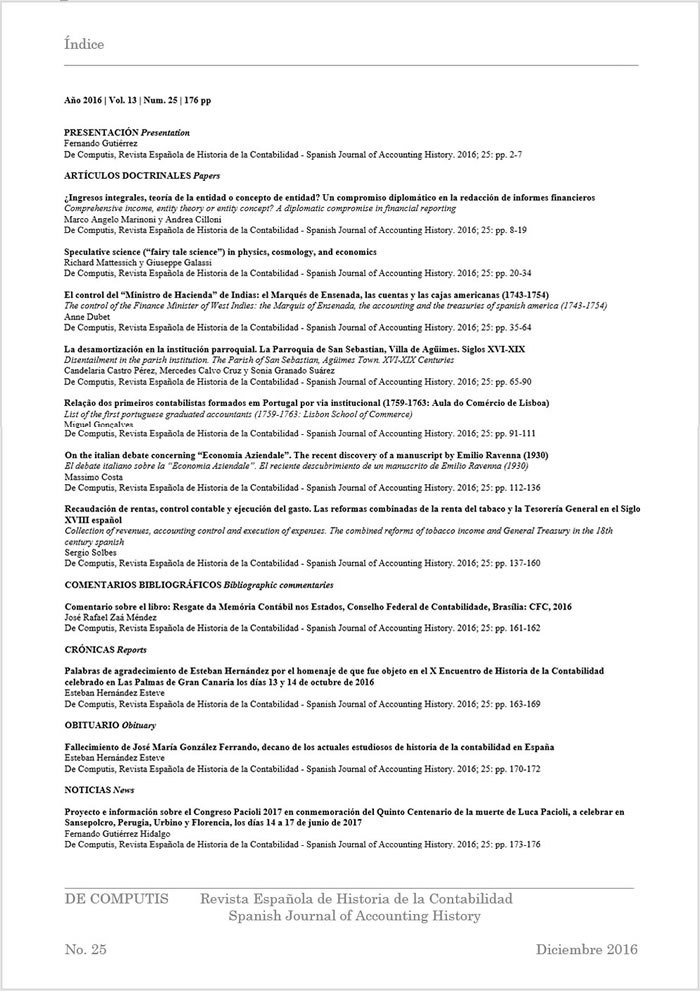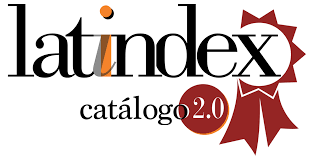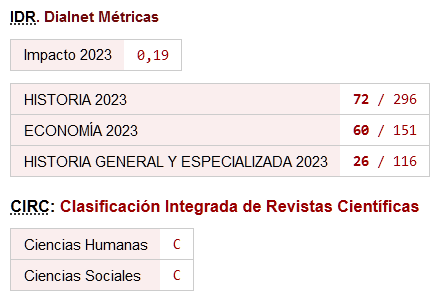¿Ingresos integrales, teoría de la entidad o concepto de entidad?
un compromiso diplomático en la redacción de informes financieros
DOI:
https://doi.org/10.26784/issn.1886-1881.v13i25.261Palabras clave:
Historia de las teorías contables, Fair-value, Realización, Teorìa de la EntidadResumen
La globalización de los mercados y aumento de la cooperación internacional en los sistemas armonizados de contabilidad han puesto en relieve las dificultades inherentes a la elaboración de principios de contabilidad comúnmente aceptados. FASB e IASB están trabajando – a través de proyectos compartidos – en la realización de un “conceptual Framework Project” que llevará a un incremento en el conocimiento y en la comprensión de los principios de convergencia contable internacional.
El proceso de armonización internacional ha definido el concepto de “resultado integral”, es decir, una nueva estructura de la cuenta de resultados, en el que residen claramente incluso cargos y ganancias no realizadas.
El balance y los estados financieros en general, siguen manteniendo un enfoque de valoración propensos a la teoría de la propiedad, teniendo en cuenta el accionista, como portador principal de interés social.
Descargas
Citas
Alexander D. and Servalli S. (2011). Economia aziendale and financial valuations in Italy: Some contradictions and insights, Accounting History, Vol. 16, N. 3, pp. 291-312. https://doi.org/10.1177/1032373211407052
Andrei P. and Quagli A. (2010). Il fair value nel bilancio di esercizio: potenzialità e limiti nella prospettiva della dottrina economico-aziendale italiana, Economia Aziendale & Management, Scritti in onore di V. Coda, Milano, Egea, pp. 121-145.
Beattie V. and Pratt K. (2002). Voluntary annual report disclosures: what users want, research report, The Institute of chartered accountants of Scotland, Glasgow.
Beaver W. (1981). Financial reporting: an accounting revolution, Englewood Cliffs, NJ, Prentice Hall, Fi.
Biddle G., Choi J. (2006). Is comprehensive income useful? Journal of Contemporary Accounting and Economics, Vol. 2, N. 1, pp. 1-32.
https://doi.org/10.1016/S1815-5669(10)70015-1
Biondi Y. (2011). The pure logic of accounting: a critique of the fair value revolution, Accounting, Economics and Law, Vol. 1, N. 1, pp. 1-49.
https://doi.org/10.2202/2152-2820.1018
Biondi Y., Canziani A. and Kirat T. (2007). The Firm as an entity, London, Routledge. https://doi.org/10.4324/9780203931110
Camfferman K. and Zeff S.A. (2007). Financial Reporting and Global Capital Markets. A History of the International Accounting Standards Committee, 1973-2000, Oxford, University Press. https://doi.org/10.1093/acprof:oso/9780199296293.001.0001
Canning J.B. (1929). The economics of accountancy: a crytical analysis of accounting theory. NY, The Ronald Press Company.
Carmona S., Ezzamel M. and Gutiérrez F. (2004). Accounting History Research: Traditional and New Accounting History Perspectives, De Computis - Spanish Journal of Accounting History, Vol.1, N.1, pp. 24-53. https://doi.org/10.26784/issn.1886-1881.v1i1.239
Cerboni G. (1902). Saggio riassuntivo dei concetti filologico-tecnici formanti il sistema grafico-razionale logismografico per le funzioni e per i fatti amministrativi dell'azienda economica, Roma, Tipografia Elzeviriana.
Cheng C.S., Cheung J.K. and Gopalakrishnan V. (1993). On the usefulness of operating income, net and comprehensive income in explaining security returns, Accounting and Business Review, Vol. 23, N. 91, pp. 195- 203. https://doi.org/10.1080/00014788.1993.9729879
Choi J.H. and Zang Y. (2006). Implications of comprehensive income disclosure for future earning and analysts' forecasts, Seoul Journal of Business, Vol. 12, N. 2, pp. 77-109.
Degrange E. (1795). La tenue des livres rende faciles. Paris.
Dhaliwal D., Subramanyam K.R. and Trezevant R. (1999). Is comprehensive income superior to net income as a measure of firm performance? Journal of Accounting and Economics, Vol. 26, pp. 43-97. https://doi.org/10.1016/S0165-4101(98)00033-0
Di Pietra R. (2002). La cultura contabile nello scenario internazionale. Istituzioni, principi ed esperienze, Padova, Cedam.
Flegm E.H. (2006). Debate over FASB's conceptual framework ignores owners and managers. The CPA Journal, Vol. 76, N. 12, pp. 6-9.
Galassi G. (1987). Concetti costitutivi e concetti operativi di reddito, in AA.VV., Saggi di Ragioneria e di Economia Aziendale. Scritti in onore di Domenico Amodeo, Padova, Cedam.
Galassi G. (1980). Capital-Income Relations: A Critical Analysis. In Gino Zappa, Founder of Concern Economics. Bologna, Accademia Italiana di Economia Aziendale, pp. 25-49.
Galassi G. (1967). Il postulato della realizzazione nella dottrina aziendale nord-americana, Rivista dei Dottori Commercialisti, N.2, Marzo-Aprile, pp. 216-252.
Hatfield H.R. (1909). Modern accounting: it's principles and some its problems. New York, Appleton. Hendricksen E. (1977, 3rd ed.). Accounting theory, Illinois Richard D. Irwin.
Hügli F. (1923 - 3rd edition). Bookkeeping systems and forms of bookkeeping. Berne. (reprint edition, Osaka: Nihon Shoseki, 1977).
Husband G. (1954). The entity concept in accounting, The Accounting Review, Vol. 29, N. 4, pp. 552-563.
Husband G. (1938). The corporate entity fiction and accounting theory, The Accounting Review, Vol. 13, N. 3, pp. 241-253.
Kirsch R.J. (2012). The evolution of the relationship between the US financial accounting Standard Board and the IAS setters: 1973-2008, The Accounting Historians Journal, Vol. 39, N. 1, pp. 1-51. https://doi.org/10.2308/0148-4184.39.1.1
Kothari S.P., Leone A.J. and Wasley C.E. (2005). Performance matched discretionary accrual measures, Journal of Accounting and Economics, Vol. 39, N.1, pp. 163-197. https://doi.org/10.1016/j.jacceco.2004.11.002
Knutson, P.H. and Napolitano G.N. (1998). Criteria employed by the AIMR Financial Accounting Policy Committee in evaluating financial accounting standards. Accounting Horizons, Vol. 12, N. 2, pp. 170-176.
Li D.H. (1960). The nature of corporate residual equity under the entity concept, The Accounting Review, Vol. 60, N. 2, pp. 258-263.
Littleton A. C. (1966, reprint of the 1933 original edition). Accounting evolution to 1900, New York, Russell & Russell.
Markarian G. (2014). The crisis and fair values: Echoes of early twentieth century debates? Accounting Historians Journal, Vol. 41, N. 1, pp. 35-60. https://doi.org/10.2308/0148-4184.41.1.35
Newberry S. (2003). Reporting performance: comprehensive income and its components, Abacus, Vol. 39, N. 3, pp. 325-339.
https://doi.org/10.1111/j.1467-6281.2003.00136.x
Nissan D. e Penman S. (2008). Principles for the application of fair value accounting, Center for Accounting and Securities Research, Columbia University, Working Paper Number 2.
Nissley W. (1940). Charges against surplus, American Institute of Accountants, Extension of Auditing Procedures, pp. 39-42.
Paton W.A. (1922). Accounting theory. New York, Ronald Press.
Paton W.A. and Littleton A.C. (1940). An introduction to corporate accounting standards, American Accounting Association.
Previts G.J. (1980). A critical evaluation of comparative financial accounting thought in America 1900 to 1920, New York, Arno.
Previts G.J. and Merino B.D. (1998). A history of accountancy in the United States: the cultural significance of accounting, Columbus, Ohio State University Press.
Rossi G. (1884). Studi e ricerche di logismografia generale, La nuova ragioneria italiana, 2, pp. 164-247.
Schär J. F. (1890). Attempt of a scientific treatment of bookkeeping, Basel, Verband Schweizerischer Konsumvereine.
Schär J. F. (1911). General commercial economics, Part 1. Leipzig, G.A. Gloeckner.
Schär J. F. (1914). Bookkeeping and balance sheet. Berlin, Springer Verlag (later by J. F. Schär and Willy Prion. Berlin, Julius Springer, 1932).
Schmalenbach E. (1921). Monetary adjustment in the balance-based income calculation, Zeitschrift für handelswissenschaftliche Forschung. In O.F. Graves, G.E. Dean and F.L Clarke, eds. Schmalenbach's dynamic accounting and price-level adjustment, New York, Garland Publishing, pp. 3-20.
Schmalenbach E. (1959). Dynamic accounting (English translation, by G. W. Murphy and Kenneth S. Most of the 3rd ed. of the Dynamische Bilanz. Cologne, Westdeutscher Verlag, 1925), London, Gee and Co.
Sorter G. (1969). An events approach to basic accounting theory, Accounting Review, Vol. 44 (January), pp. 12-19.
Sprague C.E. (1880). The algebra of accounts, The Book-Keeper, July 20, pp. 2-4.
Sprague C.E. (1908). The philosophy of accounts, New York.
Staubus, G.J. (1959). The residual equity point of view in accounting. The Accounting Review, Vol. 34, N. 1, pp. 3-13.
Whittington G. (2008). Fair Value and the IASB/FASB Conceptual Framework Project: An Alternative View, Abacus, Vol. 44, pp. 139-168.
https://doi.org/10.1111/j.1467-6281.2008.00255.x
Zappa G. (1950, first edition, 1937, preliminary edition 1920-1929). The business income - double entries, accounts and financial statements of commercial enterprises, Milano, A. Giuffrè.
Zappa G. (1957). Production activities in the economy of entities, Milano, A. Giuffrè.
Zeff S.A. (1978), A critical examination of the orientation postulate in accounting with particular attention to its historical development, New York, Arno Press.
Descargas
Publicado
Cómo citar
Número
Sección
Licencia

Esta obra está bajo una licencia internacional Creative Commons Atribución-NoComercial-CompartirIgual 4.0.










